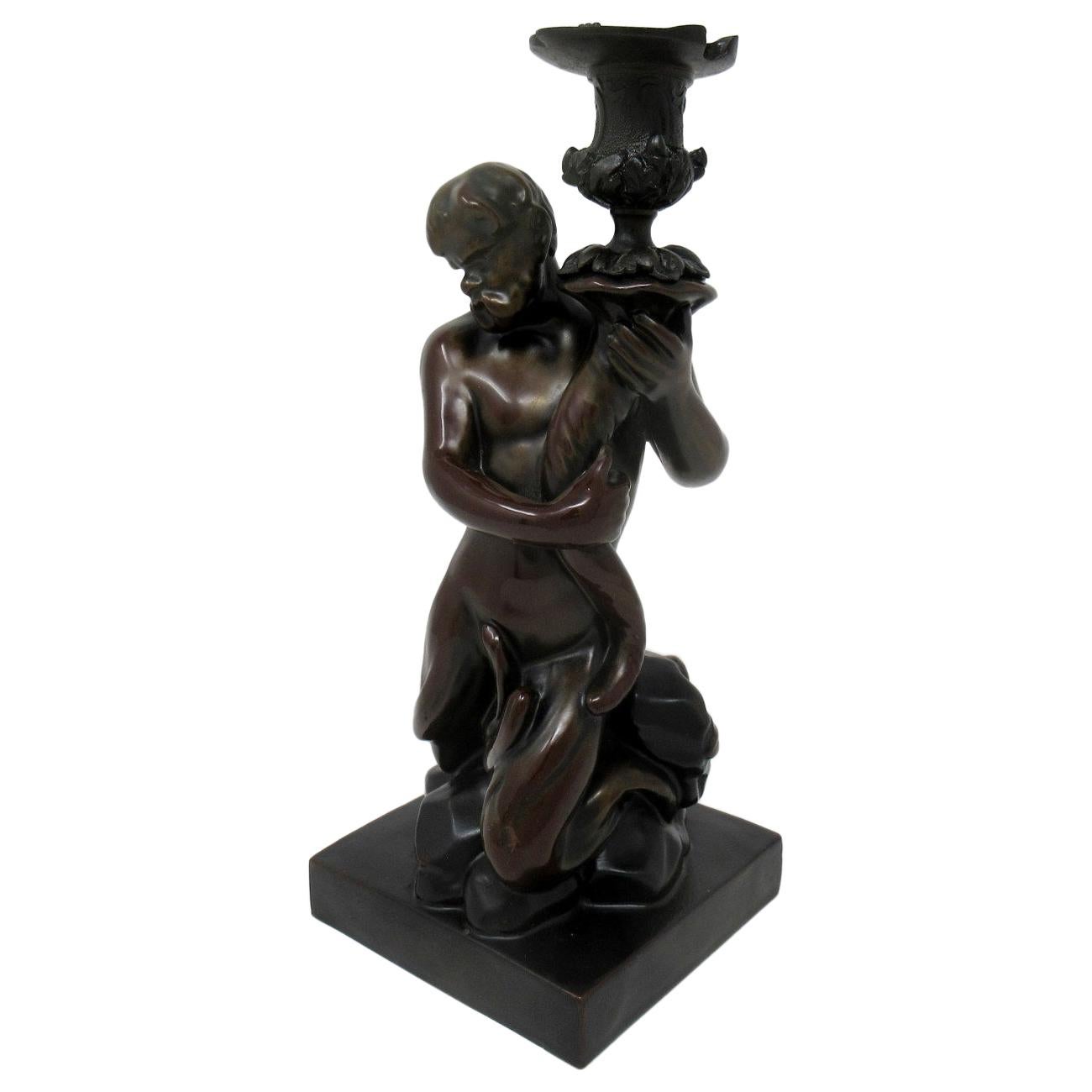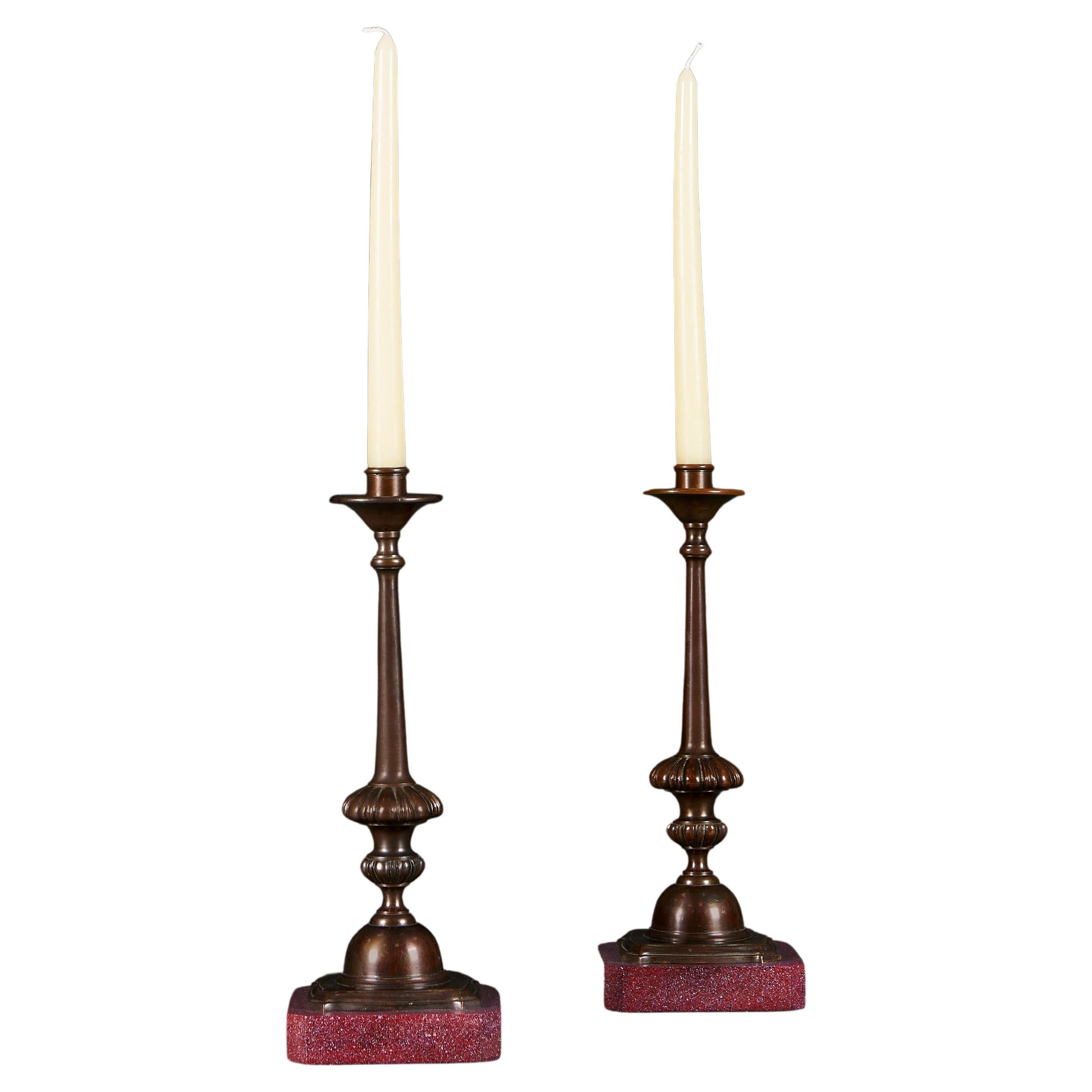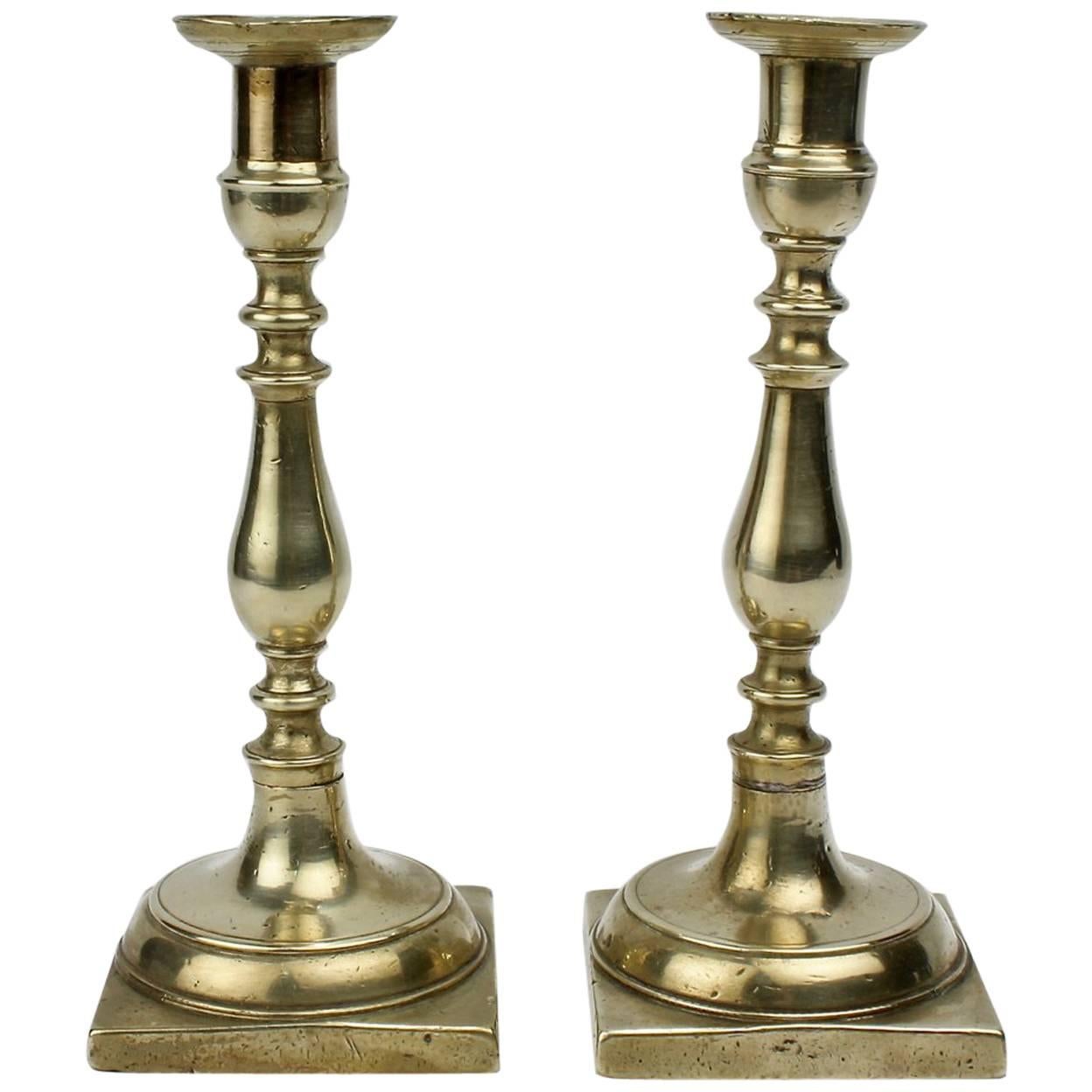Items Similar to Pair of Early 19th Century Triton Candlesticks Storm Lanterns by Wood & Caldwell
Want more images or videos?
Request additional images or videos from the seller
1 of 18
Pair of Early 19th Century Triton Candlesticks Storm Lanterns by Wood & Caldwell
About the Item
Rare and fabulous pair of Early 19th Century Triton Candlesticks by Wood & Caldwell. English lustre pottery, circa 1815. Now mounted as storm lanterns (also called hurricane lanterns or hurricane lamps).
Why we like them:
The origin of Tritons can be traced back to Greek mythology, where Triton was the son of Poseidon, the god of the sea, and Amphitrite, the sea goddess. Triton was often depicted as a messenger of the sea, blowing a conch shell to calm or raise the waves.
In art and literature, Tritons have been featured prominently in various cultures, particularly in Greco-Roman art and later in Renaissance and Baroque art. They were often depicted in sculptures, paintings, and decorative art, symbolizing the power and influence of the sea.
Tritons became popular motifs in decorative art during the Renaissance and Baroque periods, where they adorned fountains, architectural elements, and other decorative objects. They were often portrayed as powerful and majestic beings, embodying the awe and mystery of the ocean.
The imagery of Tritons has persisted through different art movements and continues to be a popular motif in decorative art and design, representing themes of maritime adventure, exploration, and the beauty of the sea.
About Wood & Caldwell:
An identical candlestick can be found in Victoria & Albert museum in London and is pictured in 'Old English Lustre Pottery' by W.D. John and Warren Baker; R.H. John Ltd, Newport, England, 1951 (see images). Various figures by Wood & Caldwell are held at the major museums, including The Metropolitan Museum of Art in New York and The British Museum in London, among others.
According to the description of the firm in the above mentioned book:
Enoch Wood was born in 1759 and after early training under Josiah Wedgwood and Henry Palmer he became a master potter in Burslem about 1781-1784, probably continuing with his father's business which he rapidly extended. Like the other members of his family he was a capable modeller and during the next forty years produced many forms and figures which can readily be recognised, ranging from the early ones of John Wesley and George Whitfield to those of the Emperor of Russia, Shakespeare, St. Sebastian, the Countess of Harrington, George III, Handel, Falstaff, Diana, Duke of Wellington, and in later years, of George Washington (c. 1818).
In 1790 Enoch Wood was joined in the business by James Caldwell of Linley Wood, of whose activities only meagre information is available: he probably had little to do with the pottery and assisted Enoch Wood with financial aid for expansion. This partnership continued until 1818 when Enoch Wood was able to gain complete control by purchasing his partner's interest : soon afterwards he took his sons into the business, which was known as Enoch Wood and Sons, Burslem. For the next twenty vears it was verv successful: Enoch Wood died in 1840 and his extensive potteries were closed by his sons in 1846.
During the twenty-eight years in which James Caldwell was associated with him in Burslem, Enoch Wood developed his natural talents as a modeller and practical potter to the maximum, and produced his most attractive examples of both domestic and artistic earthenware. Following the lead of Josiah Spode the Second and of Josiah Wedgwood the Second, he quickly adapted the new lustreing processes for the ornamentation of almost every variety of commercial earthenware, and without the slightest doubt, between 1805 and 1818, Messrs. Wood and Caldwell ranked as one of the largest producers of gold, silver and pink lustred wares in Staffordshire : their pink lustreing especially attained a most remarkably fine colour tone with a rich sheen and velvet-like appearance.
The origins of Triton candlesticks in England: Sir William Chambers & Wedgwood connection
Wedgwood has been making Triton candlesticks since the early 1770s. According to the 1995 exhibition titled 'The Genius of Wedgwood' at the Victoria & Albert Museum in London catalogue entry (see one of the images), "[Josiah] Wedgwood refers to this pattern in a letter of November 1769: 'Mr Chambers lent me the model of the Triton Candlestick, & was to have the first pair as a present, pray make my comp', with them'. These were presumably made in Basalt, and versions in Jasper were in production by 1787. Triton candlesticks are listed in the 1773 Catalogue, where they are said to be from Michael Angelo. The pair to the triton supplied by Chambers to Wedgwood was probably modelled by John Bacon, a sculptor who also worked for Duesbury's Derby factory, where the design was produced in porcelain (Cat. D40). Similar tritons also appear in the pattern books of Boulton & Fothergill, who in 1771 sold a 'tryton in dark bronz'; the model for this was probably obtained from either Wedgwood or Chambers." Sketches of Tritons from Sir William Chambers's Franco-Italian Album, held at Victoria and Albert Museum in London, are also offered among the images to this listing.
- Creator:Wood & Caldwell (Maker)
- Dimensions:Height: 21.26 in (54 cm)Width: 5.91 in (15 cm)Depth: 5.91 in (15 cm)
- Sold As:Set of 2
- Style:Regency (Of the Period)
- Materials and Techniques:
- Place of Origin:
- Period:
- Date of Manufacture:Circa 1815
- Condition:Wear consistent with age and use. Minor losses. Wear commensurate with age, rubbing and wear to gilding, minor chips to bases. Removable glass shades possibly a later addition.
- Seller Location:London, GB
- Reference Number:1stDibs: LU1781238776022
About the Seller
5.0
Platinum Seller
These expertly vetted sellers are 1stDibs' most experienced sellers and are rated highest by our customers.
Established in 2014
1stDibs seller since 2016
211 sales on 1stDibs
Typical response time: <1 hour
Associations
LAPADA - The Association of Arts & Antiques Dealers
- ShippingRetrieving quote...Ships From: Richmond, United Kingdom
- Return PolicyA return for this item may be initiated within 7 days of delivery.
More From This SellerView All
- Pair of 19th Century Ormolu and Patinated Bronze CandelabraLocated in London, GBA fine pair of Regency period gilded and patinated bronze candelabra or candlesticks. English, circa 1810. Why we like them Exquisite, late neoclassical design; beautiful co...Category
Antique Early 19th Century English Regency Candelabras
MaterialsOrmolu
- Antique Bronze Etruscan Candelabrum 19th CenturyBy F. Barbedienne FoundryLocated in London, GBAn exquisitely cast and patinated bronze 'Etruscan' candelabrum in the Grand Tour taste. France or Italy, mid- to late 19th century. Why we like it We love the finest quality of cas...Category
Antique 19th Century French Grand Tour Candelabras
MaterialsBronze
- Pair of Regency Klismos Chairs, attributed to Gillows, early 19th centuryBy Gillows of Lancaster & LondonLocated in London, GBA very fine and elegant Regency period set of eight 'Klismos' chairs after designs by Thomas Hope, the manufacture attributed to Gillows England, circa 1810. Why we like them The...Category
Antique Early 19th Century English Regency Armchairs
MaterialsUpholstery, Hardwood
- Early 19th Century Armchair attributed to GillowsLocated in London, GBA fine quality early 19th century Regency, George IV period open armchair, attributed to Gillows of Lancaster and London. English, circa 1825. Illustrated: British Furniture: 182...Category
Antique Early 19th Century English Regency Armchairs
MaterialsGold Leaf
- Antique Grand Tour Urn Vase, Early 19th CenturyLocated in London, GBA charming Grand Tour style porcelain vase, matte black ground with polychrome decorations in ancient Greek style, English, mid-19th century.Category
Antique Mid-19th Century English Regency Vases
MaterialsPorcelain
- Antique Slipper Chair Early 19th CenturyLocated in London, GBAn interesting early 19th century slipper chair of small proportions, retaining original needlework upholstery, English, circa 1835. The chair p...Category
Antique Early 19th Century British Early Victorian Slipper Chairs
MaterialsUpholstery, Hardwood
You May Also Like
- Staffordshire Figure of Male Triton John Flaxman by Wood Caldwell 19th CenturyLocated in Dublin, IrelandRare Bronze Glazed Staffordshire Pottery Male Nude Figure of a Triton made by Wood and Caldwell after a bronze by John Flaxman 1755-1826, first quarter of the Nineteenth Century....Category
Antique 19th Century English Regency Candlesticks
MaterialsCeramic, Porcelain
- Early 19th Century Pair of Mahogany CandlesticksLocated in High Point, NCPair of English mahogany candlesticks, circa 1810. The tops are made from heavy cast brass, and are supported on hand turned and carved decorated stems with wonderfully square pedest...Category
Antique Early 19th Century English Regency Candlesticks
MaterialsBrass
- Early 19th Century Regency Pair of Bronze CandlesticksLocated in Dublin 8, IEEarly 19th century Regency pair of bronze candlesticks in the form of winged sphinx raised over stepped plinth surmounted with ornate candle nozzle with foliate motif.Category
Antique Early 19th Century Irish Regency Candlesticks
MaterialsBronze
- A Pair of Early 19th Century Bronze CandlesticksLocated in London, GBEngland, circa 1820 A pair of early nineteenth century bronze candlesticks, with tapering stems and urn shaped bases, supported on faux porphyry plinths. Height 33.00cm Width 12.00cmCategory
Antique Early 19th Century Candlesticks
MaterialsBronze
- Pair of Early 19th Century Continental Brass CandlesticksLocated in Philadelphia, PAA Fine and very solid pair of early 19th century brass Continental candlesticks. Likely Northern European (or possibly Russian) in origin. ...Category
Antique Early 19th Century European George III Candlesticks
MaterialsBrass
- EARLY 19th CENTURY PAIR OF CARLO X BRONZE CANDLESTICKSLocated in Firenze, FIPair of graceful bronze candlesticks belonging to the Charles X period. The candlesticks are characterized by particular finishes in gilded bronze and burnished bronze. Each candelab...Category
Antique Early 19th Century French Charles X Candlesticks
MaterialsBronze





